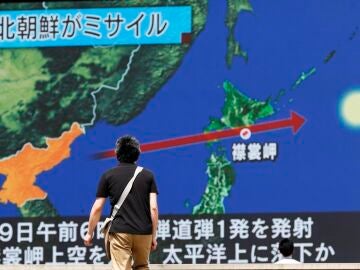
North Korea launched today, two days after firing an intercontinental missile, two short-range shells to the Sea of Japan (called the East Sea in the two Koreas) in apparent response to the air maneuvers carried out by Seoul and Washington the day before, according to detailed media of the regime and the South Korean army.
The Joint Chiefs of Staff (JCS) indicated in a statement that it detected two short-range ballistic missiles (SRBM) launched from the vicinity of Sukcheon, about 50 kilometers north of Pyongyang and that the projectiles fell into the waters of the Sea of Japan after traveling 390 and 340 kilometers, respectively.
For its part, the North Korean state agency KCNA reported that the army conducted tests firing two projectiles into the Sea of Japan. using a 600mm multiple rocket launcher which he described as capable of carrying out a “tactical nuclear strike” and to respond to the air capabilities of the allies.
This rocket launcher, a large artillery device that is a modification of the system known as KN-25 and whose projectiles Seoul qualifies as SRBM, was released on New Year by the regime and In his presentation, the North Korean leader himself, Kim Jong-un, assured that he is capable of carrying tactical nuclear warheads.
These launches come a day after South Korea and the US carried out aerial maneuvers involving two Pentagon B-1 strategic bombers.
This allied action came in response to the launch of a Hwasong-15 intercontinental ballistic missile (ICBM), the second with the longest potential range in its arsenal, by the North on Saturday. the projectile traveled more than 900 kilometers and reached a peak of more than 5,000 before falling into the waters of Japan’s Special Economic Zone (SEZ), west of the island of Hokkaido.
These North Korean launches come at a time when the regular spring exercises by Seoul and Washington are being finalized, which this week are also conducting a tabletop exercise simulating a North Korean nuclear attack for the first time.
Last Friday Pionyang promised an “unprecedented response” if the allies carried out their spring maneuvers, called Freedom shield and which the regime described as “preparations for a war of aggression”.
Source: Lasexta
Ricardo is a renowned author and journalist, known for his exceptional writing on top-news stories. He currently works as a writer at the 247 News Agency, where he is known for his ability to deliver breaking news and insightful analysis on the most pressing issues of the day.












